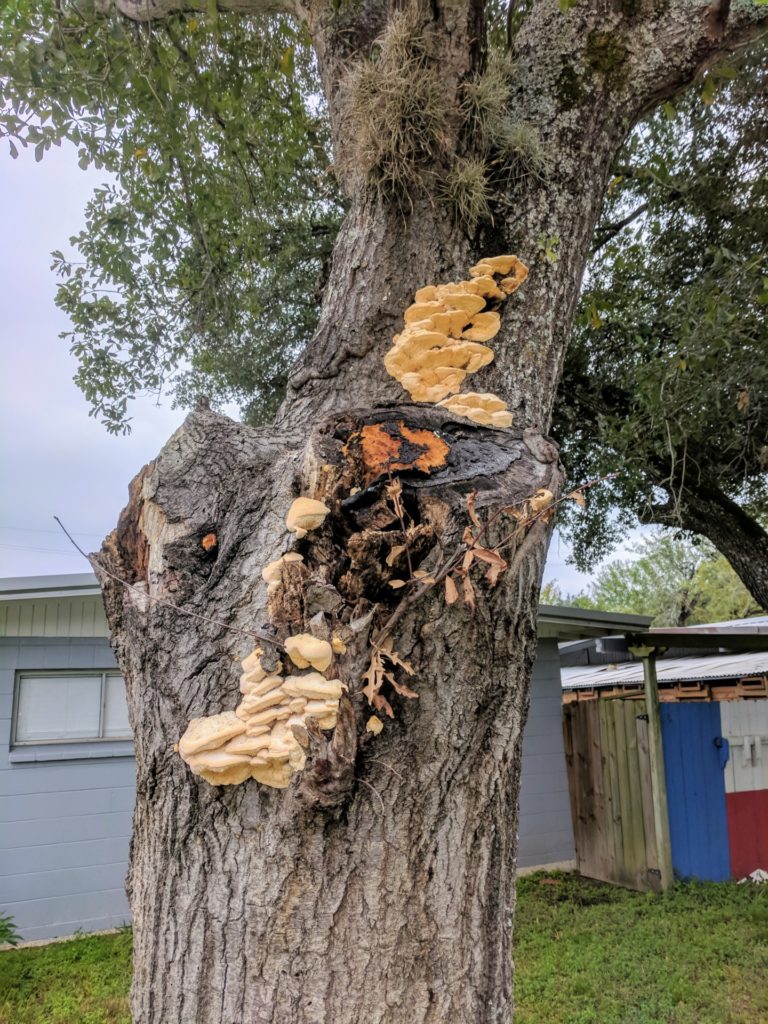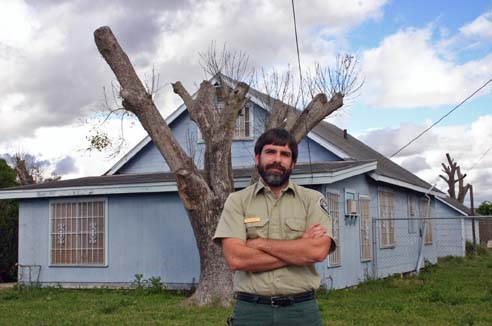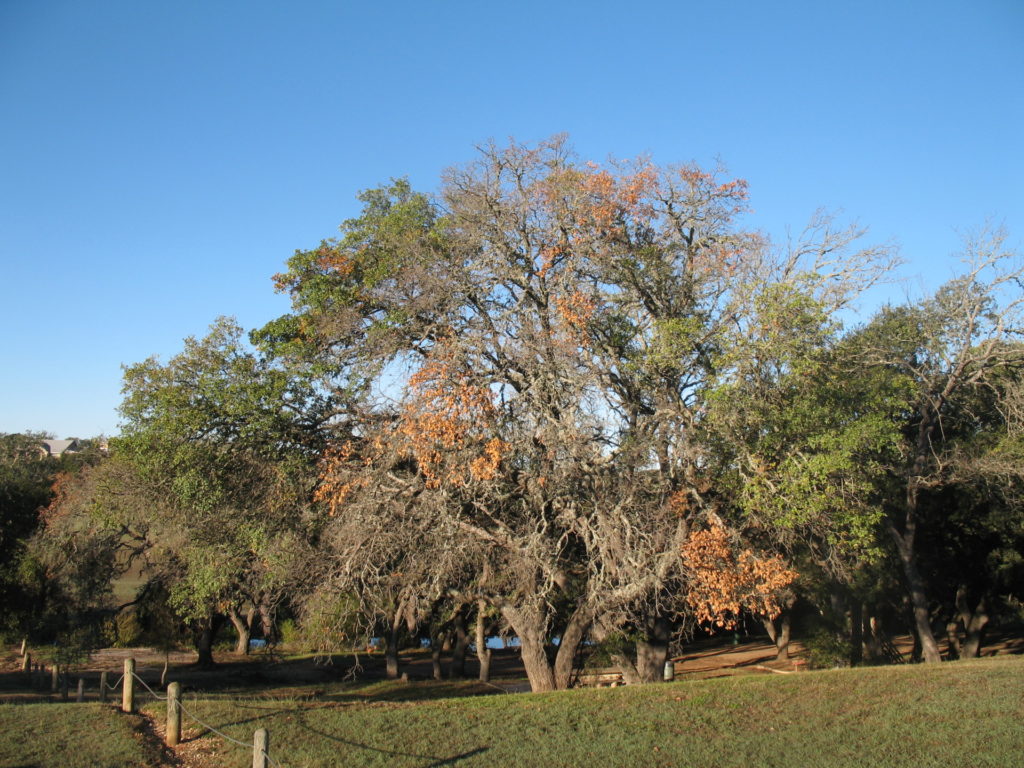Deciding when to remove a tree
To ax or not to ax … that is the question
Knowing when and how to remove a tree is more complicated than it may appear, said Texas A&M AgriLife experts.

“While dead or dying trees in natural areas are not usually dangerous to people or property, those near homes, roads and power lines can be hazardous if they have structural defects that could cause the tree or a significant portion of it to fall,” said Gretchen Riley, Texas A&M Forest Service staff forester and a certified arborist, College Station.
“Trees that could possibly injure people or damage property should be given immediate attention to determine if and how they should be removed.”
Riley said badly damaged, sick or seriously injured trees, as well as some invasive species, may also be candidates for removal.
“If the tree owner has doubts about the general health of the tree, it should be evaluated by a certified arborist,” she said. “Certified arborists are experts in various aspects of tree care and should be consulted when evaluating the health of a tree to determine if it should be removed.”
Some of the main reasons for removing a tree include:
- It poses a potential danger to people or property.
- It has been badly damaged and likely will not survive.
- It has experienced a significant amount of decay.
- It has succumbed to disease or insect pressure.
- It is the wrong type of tree for the environment in which it was planted.
- It is an invasive species that will negatively impact native species.
- It has structural deficiencies that will eventually cause it to fall on its own.
Evaluating a tree for removal

Riley said it’s usually easy to determine if a tree is truly dead or well on its way to failing and needs to be removed.
“A tree is dead if it has had no green leaves for a full growing season,” he said. “It needs serious attention if it has new, unsealed gaping wounds or long vertical cracks in the trunk or abnormally peeling bark, multiple branches with no living buds and ‘fruiting bodies,’ which are types of fungi, growing at the bottom of the trunk near or along the tree’s roots.”
She said another circumstance that will likely warrant removal is if the entire trunk is leaning 30 degrees or more off-center.
However, she said, determining whether or not to remove a tree becomes more complicated if the tree is still living but has been badly damaged or is in a state of poor health or decay.
“Again, a certified arborist has the knowledge and experience to evaluate the health of the tree and help you decide if it can be saved or should be removed,” she said.
Applying the 25% rule
Riley said the “25% rule” is a good general rule to use in assessing a large tree’s survivability after damage.

“If 25% or less of the crown of the tree is damaged, the tree will likely survive,” she said. “You can probably prune the damaged branches back and reshape the tree. In some instances, even if 50% of the crown is damaged, especially if the damage is mostly to smaller branches, the tree can still survive. It depends on the location and extent of damage.”
However, she said, if the tree has a new gaping wound that won’t seal, as well as a significant amount of crown loss, the tree likely will not recover. The same is true if a trunk has a large vertical crack down the trunk caused by a lightning strike or wind torqueing.
Riley also noted the 25% rule applies to tree root systems that have been damaged by excavation or other means, especially if the damage is to smaller, less supportive roots.
Trees should be watched from year to year, Riley said. Property owners should become familiar with their overall health and look for signs of decline to help determine if they may need removal.
“Knowing your trees will help you decide whether there is some time before you need to remove it or whether its removal should be imminent,” she said.
Location, location, location
Planting the wrong type of tree for a location or planting a tree in the wrong location can also lead to the need for tree removal, said David Rodriguez, Texas A&M AgriLife Extension Service horticulturist for Bexar County, San Antonio.

“The wrong tree for a location can potentially pose a danger to people,” Rodriguez said. “For example, a tree growing under an electrical line can create a serious safety hazard if one of its branches fails and causes the line to break. For such a location, it’s best to choose a suitable tree that will mature at a height of less than 25 feet.”
Rodriguez said if a tree is not well adapted for the area where it is being planted, it may survive for several years, but it will often be sickly, have limited growth and have a less-than-optimal appearance.
The Texas Tree Planting Guide from the Texas A&M Forest Service provides helpful guidance for proper tree selection throughout the state.
Rodriguez also noted September through November is the ideal time for tree planting in Texas because planting during that time allows the roots to establish before the ground freezes and winter sets in. However, he said, it’s best not to continue planting trees later into the fall as this may negatively affect plant health.
Invasive and ‘undesirable’ trees
Riley said there are some invasive tree species that may grow well in the state but are problematic for native trees.
“I’m pretty welcoming when it comes to most types of trees, but I usually recommend people stay away from Chinese tallow, chinaberry trees and Bradford pear trees,” she said. “I also suggest removing these trees if they somehow find their way onto their property.”

Chinese tallow can quickly eradicate and replace native tree species and its leaves and fruit are toxic to humans and cattle. Chinaberry trees are very messy due to the dropping of their leaves and berries, and those berries can be poisonous to humans and livestock. Bradford pear trees can grow to 30 feet tall but have a weak branch structure and can break apart in less than 20 years, posing a potential danger to anyone near them when they finally fail.
Riley said the TexasInvasives.org site provides information on these and other invasive tree species.
Some characteristics that may make some trees “undesirable” to their owners and therefore potential candidates for the chopping block include those that:
- Are prone to breakage.
- Drop a large quantity of debris.
- Have shallow roots that can damage lawns and pavement.
- Are more susceptible to disease or insect pressure.
Insect and disease pressure, environmental stress
“Insect and disease pressure can often weaken or kill a tree, depending on how strong or pervasive that pressure may be,” said David Appel, Ph.D., AgriLife Extension plant pathology specialist, College Station, College Station.
Appel said tree diseases and aggressive insect pests can badly weaken or kill trees as well as cause further complications with tree removal.
“For example, oak wilt can kill a tree,” he said. “If 30% or more of the crown is symptomatic for oak wilt, the tree is probably beyond treatment and will eventually need to be removed. However, some trees can survive oak wilt without treatment, and then it becomes a personal choice as to whether it looks good enough to keep.”
He also noted ash borers and other wood boring insects can kill weakened trees over time, and heart rot fungi can weaken the structural integrity.
Appel said recently planted young trees may also need to be removed if they are improperly planted and/or fail to establish once they have been transplanted.
“Both younger and older trees try to let you know when they are ill or in distress and exhibit certain symptoms that can tell you what’s wrong with them,” Appel said. “Some signs of distress include drooping branches, lack of foliage, premature leaf drop, wilting or brown leaves, scorched or spotted leaves, and the presence of fruiting bodies near the base.”
Riley said it’s important to learn how trees may react under certain environmental conditions or stresses.
“For example, in times of drought many trees will refrain from producing leaves to save on water, but that doesn’t necessarily mean they are in great distress,” she said. “Different tree species behave differently under certain conditions, so it’s good to know your trees and understand their biology and what’s normal for them.”
She said the TreeMD web application can be helpful in determining if a tree has a serious health issue. Additional help is available through AgriLife’s Texas Plant Disease Diagnostic Laboratory.
Tree removal not a do-it-yourself project
Rodriguez said the vast majority of tree removal is unsafe for the average person to attempt.
“Professional removal companies have a certified arborist on staff or available to them to assess the health of the tree as well as the equipment and expertise needed to safely remove it,” he said. “Most homeowners do not have the proper equipment or skill level to do such work. Tree work is actually very complicated, technical and potentially dangerous, and many homeowners have been injured or even killed trying to do it themselves.”
Rodriguez said some of the factors leading to accidents during attempts by non-professionals to remove trees include the misuse of ladders, insufficient restraints for avoiding falls, improper use of tools and lack of knowledge of physics and/or tree structure and biology.



